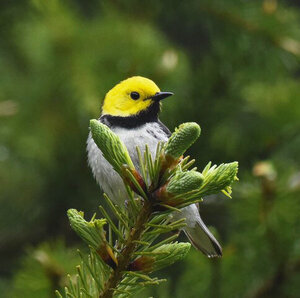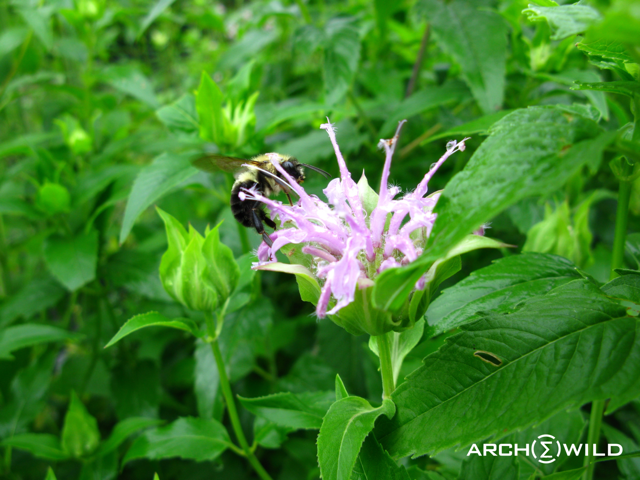Native Planting in Big Cities / by Banford Weissmann
New York City is essentially a giant ecologic scar with hard, impermeable surfaces stretching out over hundreds of square miles. Natural green spaces are relegated to a few places here and there, and trees poking out of sidewalks struggle to survive. Can an Idea like Homegrown National Park™ even work in a place where habitat fragmentation is so extreme?
Luckily, many talented and motivated New Yorkers believe it can. Over recent years, the number of groups that have sprung up to address our degraded environment has proliferated. Doug Tallamy’s message is well-known and well-received with this crowd. A lot of networking and collaborating is occurring as we try to figure out ways to promote and sustain biological diversity and ultimately create a healthier environment for us all. Local scientists and researchers are busy cataloging our native insect and bird populations – after all, we can’t know what we’re at risk of losing if we don’t know what we have in the first place.
PUBLIC SPACES
Of the green areas that we do have, most are public spaces that fall under the auspices of the NYC Department of Parks and Recreation. Fortunately for us, leaders in the Parks Department have become more attuned to the concept of Homegrown National Park. For instance, the head of horticulture for the entire Parks system has recently developed guidelines to make sure that 60% of new plants that go into Parks properties are native straight species and another 25% have to be native to the Northeast.
What can one person do in such a big city to make a difference?
Most people in NYC don’t have a private yard to work with and it’s not as if one can just buy a couple of native trees at the local nursery and pop them into the park down the street.
For those who want to get involved, several points of access exist. Park conservancies, foundations, “Friends of…” groups and other environmentally-oriented non-profits, offer volunteer opportunities to work in parks and public spaces. Because these organizations often have relationships with entities like the Parks Department, they can actually have a say in what gets planted. Many of the groups provide training and have outreach and educational programs to increase public awareness of the restoration work they are doing.


CARL SCHURZ PARK
My own access point was as a volunteer gardener at Carl Schurz Park through a program hosted by the park’s Conservancy. This beloved 15-acre park sits along the East River in the Yorkville neighborhood of Manhattan. Volunteering provided me with the access to nature that I craved. After a few years, I became a part-time horticulturist at the park, and subsequently pursued a career in landscape design. The Conservancy, made up of staunch supporters of Tallamy’s message, asked me to redesign sections of the park with the purpose of creating spaces that provide beneficial habitats for birds and pollinators. Over the last few years, we have installed native woodlands and pollinator gardens throughout the park. Anything that gets planted must provide benefits for our avian and/or insect populations. We keep records of which species visit the park and what they are attracted to. Our maintenance practices have been updated to support healthy habitats. Happily, our work seems to be paying off. Carl Schurz Park is now an eBird Hotspot with sightings of at least 136 species of birds. The diversity of birds that stay in our park all year is growing, and we have even been able to support a couple of rare birds that ended up here over the winter.
Educating park visitors about our efforts is an important part of our overall plan. We want people to understand the importance of an ecologically rich landscape and to find joy in seeing the park in a whole new way. We give tours and talks on what we are doing and why. This year, we are launching a series of videos that cover everything from our stewardship philosophy to information on the bees and birds that visit our plants. We are creating YouTube videos on ecologically sensitive garden maintenance. Soon, we will be releasing a GIS park map that highlights the benefits of our native landscape. We amplify the messages in our newsletter, and the Conservancy website contains regular features called What’s in Bloom and What’s in Flight.


The most challenging green spaces to maintain in NYC are our street tree pits. They also happen to be the most abundant – there are more than a half million of them. Vulnerable to foot traffic and dogs, sprayed with road salt and slush from cars, they are harsh places that tend to dry out quickly and are difficult to water. Super-dedicated gardeners often have to cart full jugs of water back and forth from their buildings to keep the plants alive during hot summer months. A huge percentage of the tree pits aren’t tended at all. While they are officially the Parks Department’s responsibility, it doesn’t have nearly enough resources to take care of them. These are the very spaces, however, that could play an enormous role in defragmenting our landscape.
APARTMENT BUILDINGS


Another place where Homegrown National Park has the potential to take root is in the garden areas of residential buildings. Discussions on what to do with a building’s greenery typically revolve around seasonal color for a low price, so one sees a lot pansies, impatiens, begonias and tulips. Any trees and shrubs tend to be ornamental non-natives. Reaching the decision-makers of these properties will make a huge difference but will take a concerted and sustained effort.
Residential buildings with the most significant green spaces are our public housing complexes. The buildings are typically surrounded by inaccessible lawns. Some have tall trees, but many of those are London Planes which don’t provide much in the way of ecologic benefits. Unfortunately, landscapes at these complexes are low on the priority list, as the buildings themselves are in dire need of repair and available resources are scarce. Community-involved restoration here could play a key role in restoring ecosystem services including carbon sequestration and cleaner air.
One question I’m often asked is where can you even buy native plants around here?
Many of the local plant shops sell ornamentals that come from other geographical regions or one sees the same old selection of impatiens, pansies, etc. Often, indoor plants are mostly what’s available. So where do you turn? For the most part, you will have to look outside the city. However, one place in Brooklyn, Gowanus Nursery, does sell some natives and places like Prairie Moon Nursery and Izel Plants will ship plants to you. The Greenbelt Native Plant Center in Staten Island has natives available for those who are planting in public spaces. Otherwise, if you have the time and a car, you can go outside the city to find a variety of native offerings.
We are fortunate to have two botanical gardens, New York Botanical and Brooklyn Botanic, both of which offer a whole slew of excellent classes and lectures on creating native landscapes. They are truly inspirational places to visit and do have some native plants for sale.
Overall, we have come a long way to rebuild our environment, but we clearly have quite a way to go. I’ve just scratched the surface on what we’re doing and what needs to be done. The pandemic in our hard-hit city has fostered a widespread and deep appreciation for our green spaces. Birding has become the hottest new pandemic pastime. Rising sea levels are forcing us to make big decisions on how we build our landscapes for the future. While our task is Sisyphean, I am hopeful that we can heal the scar. But we’re going to need all hands on deck.
*Banford has a BA in Geography with a focus on ecology and development economics. She received her Landscape Design Certification from the New York Botanical Garden School of Professional Horticulture. She launched Banford Landscapes in 2014. You can learn more about Banford at www.banfordlandscapes.com


